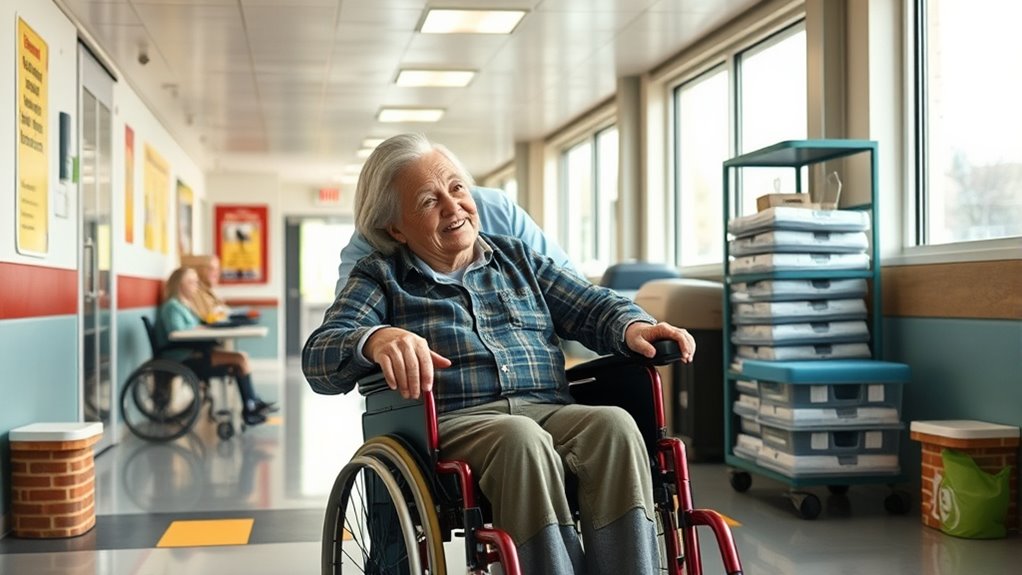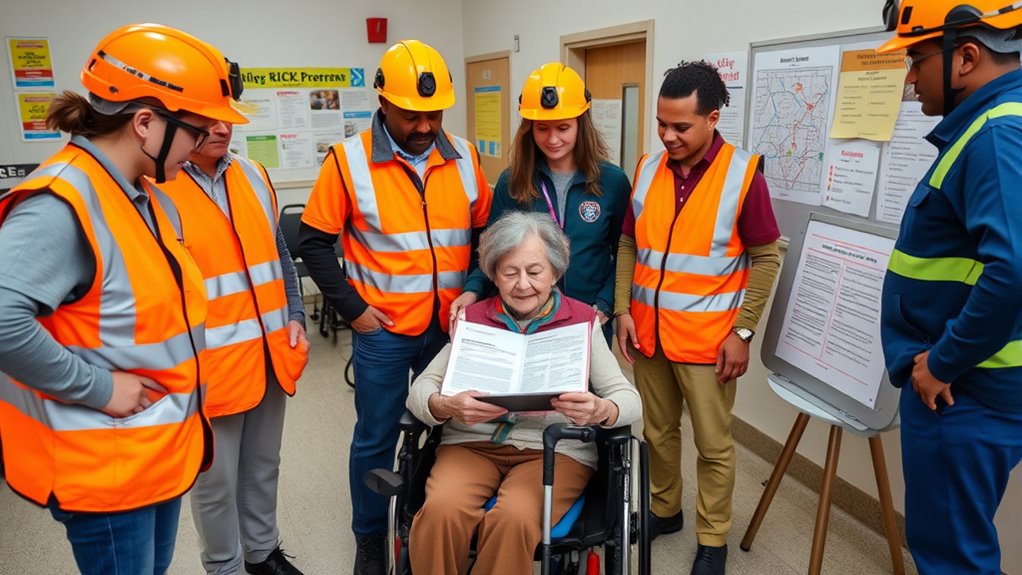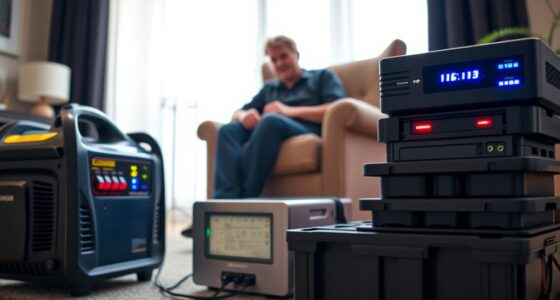To plan effectively for seniors with disabilities during disasters, you should develop accessible communication methods, like visual alerts and vibrating devices, and create evacuation routes that accommodate mobility aids. Partner with local agencies to identify accessible shelters, and guarantee transportation options are adaptable. Regularly update and personalize emergency plans, and educate seniors about their procedures. If you’d like to learn more, you’ll discover practical steps to build a truly inclusive disaster response.
Key Takeaways
- Develop personalized emergency plans addressing specific mobility, hearing, and vision needs of seniors with disabilities.
- Ensure accessible communication methods, including visual alerts, sign language, and vibrating devices, are in place.
- Design evacuation routes and shelters that are wheelchair accessible and equipped with necessary accommodations.
- Collaborate with community organizations to identify and prepare accessible resources and support systems.
- Educate seniors and caregivers on emergency procedures and regularly update accessibility features and contact information.

Are you prepared to protect seniors with disabilities during a disaster? Ensuring their safety requires thoughtful planning, especially around emergency communication and accessibility accommodations. When a disaster strikes, clear and accessible communication becomes crucial. You need to establish multiple channels that seniors can easily access, such as phone calls, text alerts, emails, or even printed notices for those with hearing or visual impairments. Remember, not everyone can rely solely on digital alerts or standard messaging systems. Incorporating visual aids, large print materials, or sign language interpreters can make a significant difference. It’s essential that your emergency communication plan accounts for various disabilities, ensuring information reaches everyone effectively and promptly. Using inclusive communication systems can further enhance accessibility for all community members. Accessibility accommodations should be at the core of your preparedness efforts. Think beyond just providing information; consider how seniors with disabilities can safely evacuate and access emergency services. For example, if a senior uses a wheelchair, ensure that evacuation routes are wheelchair accessible and that there are designated safe spots nearby. If someone has hearing loss, provide visual alerts or vibrating notification devices to signal emergencies. Visual aids, tactile signs, and clear instructions tailored to specific needs ensure that no one is left confused or unsafe. Also, consider the physical environment—make sure that emergency exits, shelters, and transportation options are accessible for all mobility levels. Collaborate with local agencies to identify accessible shelters equipped with necessary accommodations, such as ramps, elevators, and accessible bathrooms. Additionally, integrating emergency communication systems that are inclusive can significantly improve response effectiveness during crises. Effective disaster planning involves proactive communication with seniors and their caregivers. Encourage them to create personalized emergency kits that include necessary medications, adaptive devices, and important documents. Educate them about the importance of updating contact information and reviewing accessibility features regularly. Make sure they understand how to receive and interpret emergency alerts tailored to their needs. You should also work with community organizations, healthcare providers, and local authorities to ensure that emergency communication systems are inclusive and capable of reaching seniors with diverse disabilities. Ultimately, preparing for a disaster isn’t just about having a plan on paper; it’s about creating an environment where seniors with disabilities feel informed, supported, and safe. Prioritizing accessible communication and accommodations ensures that no one is left behind when disaster strikes. By doing so, you build resilience within your community and give seniors the confidence that help and information will reach them, no matter their unique needs.
Frequently Asked Questions
How Can Caregivers Assist Seniors in Disaster Preparedness?
You can help seniors prepare for emergencies by focusing on home safety and communication strategies. Make certain their home is safe, accessible, and has necessary supplies. Develop clear communication plans, including emergency contacts and alternative ways to reach loved ones if phone lines are down. Practice these strategies regularly, so seniors feel confident and prepared. Your support makes a big difference in helping them stay safe and resilient during disasters.
What Legal Rights Do Seniors With Disabilities Have During Emergencies?
Think of legal rights during emergencies as a sturdy shield protecting you. Seniors with disabilities have legal protections that make certain of fair treatment and access to emergency services. Your emergency rights include priority evacuation, accessible communication, and accommodations. These laws, like the Americans with Disabilities Act, help guarantee you’re not left behind. Knowing your rights empowers you to advocate for yourself and ensures emergency responders respect your needs during crises.
How to Ensure Medication Access During a Disaster?
To guarantee medication access during a disaster, you should prioritize medication management by keeping an updated list of prescriptions. Contact emergency pharmacies beforehand and learn their procedures for urgent needs. Store extra medication supplies, if possible, and keep a copy of your prescriptions. During emergencies, communicate with local health authorities and emergency services for assistance. Planning ahead helps prevent interruptions and ensures you stay protected when disaster strikes.
What Community Resources Are Available for Disabled Seniors?
You might wonder what community resources can truly support disabled seniors. As you explore, you discover community centers offering tailored activities and support groups providing emotional aid. These resources could be essential during emergencies, offering both practical help and companionship. Staying connected ensures you’re not alone when it matters most. Reach out now to local agencies to learn how these community services can bolster your safety and well-being in any situation.
How to Customize Emergency Plans for Different Disabilities?
When customizing emergency plans, you should consider each person’s unique needs, such as their use of assistive technology and mobility aids. You can tailor plans by ensuring these tools are easily accessible and functional during emergencies. For example, include steps for quickly securing or charging assistive devices, and identify safe, accessible evacuation routes that accommodate mobility aids. Personalizing plans makes sure every individual receives the support they need to stay safe.
Conclusion
So, while you might think disasters are rare or far away, planning for seniors with disabilities isn’t just smart—it’s essential. Ironically, the very precautions that protect you during a crisis can save lives, yet many overlook them until it’s too late. Don’t wait for an emergency to realize the importance of preparedness. Take action now, because when disaster strikes, being prepared isn’t just wise—it’s lifesaving.








